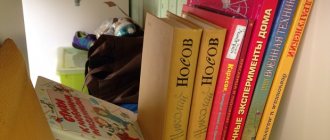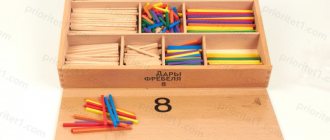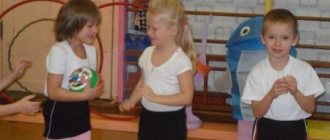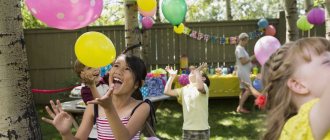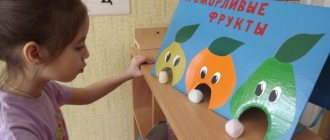Game space markers
Children are always willing to do something. This is very useful, and therefore not only should it not be interfered with, but measures must be taken to ensure that they always have something to do
Y. A. Komensky
The organization of an object-based play space and an object-developmental environment is a necessary condition for the formation of a child’s play and cognitive activity. The task of a preschool institution is to create a subject-development environment in a group that would provide the child with all kinds of material for his active participation in various types of activities. The space of the playroom must be organized in such a way that it allows children to move freely, allowing several groups of children to play at the same time, so that, if necessary, any child can retire to engage in individual activities. Solving this problem is impossible without creating a new type of play space markers .
The project “Requirements for the creation of a subject-development environment that ensures the implementation of the basic general education program of preschool education” presents the following psychological and pedagogical requirements:
- Materials and equipment should create an optimally rich (without excessive abundance) holistic, multifunctional, transformable environment and ensure the implementation of the basic general education program in the joint activities of adults and children, not only within the framework of direct educational activities, but also during routine moments.
- Traditional materials and materials of the new generation should be selected in a balanced manner, the environment should not be archaic, it should be in tune with the times, but traditional materials that have shown their developmental value should not be completely replaced in favor of the “new” as valuable in itself
- The following principles should be followed:
multifunctionality of the environment, providing for the provision of all components of the educational process and the possibility of varied use of various components of the subject-development environment;
- transformability , which provides the possibility of changes in the subject-development environment, allowing, depending on the situation, to bring to the fore one or another function of space;
- variability , determined by the type of preschool educational institution, the content of education, cultural and artistic traditions, climatic and geographical features
- It is necessary to take into account gender specifics and provide the environment with both general and specific material for girls and boys.
- The general patterns of child development at each age stage should serve as guidelines for the selection of materials and equipment.
- The selection is carried out for those types of child activities that are most conducive to solving developmental problems (play, productive, cognitive-research, communicative, labor, musical and artistic) as well as to enhance the child’s motor activity.
- Materials and equipment must meet hygienic, pedagogical and aesthetic requirements.
- The material for the game is classified based on its plot-forming function, and should include operating objects, character toys and markers (signs) of the playing space.
Having studied in detail the requirements for creating a subject-development environment, we analyzed the existing conditions in the group. It turned out that the created subject-development environment meets only some FGT, the principles of its construction are not always taken into account, and the qualitative and quantitative composition of the subject-development environment suffers. In this regard, the goal of our work was to create new creative space markers that optimally meet the above requirements. The following tasks were also defined:
- Analyze existing markers of the playing space.
- Select a material that meets hygienic and aesthetic requirements
- Develop new and varied marker models for different types of activities.
- Make markers.
- Try the markers in practice.
- Identify deficiencies, eliminate identified deficiencies, and, if possible, improve models.
To produce multi-valued play space markers, we used construction cellular polypropylene sheets (a quality certificate is available). These sheets come in red, yellow, white, blue, green. They are affordable and can be easily cut with a regular construction knife or tailor's scissors. To make markers we needed:
- construction knife;
- ruler;
- scissors;
- scotch;
- self-adhesive multi-colored film.
Rice. 1. Cutting polypropylene sheet
Rice. 2. Gluing the parts of the marker using tape
The thematic content of game plots using multi-valued markers is more diverse than when using traditional markers (kitchen, store, hairdresser, etc.).
The "Ship" marker is made from a single blue polypropylene sheet. The manufacturing technology for this marker is as follows:
- The polypropylene sheet is cut into 4 equal parts.
- All parts are connected using tape. The distance between the parts must be at least 4–5 mm so that the model can be folded.
- For safety, the edges of the parts are covered with tape or self-adhesive film.
- If desired, you can stick waves, fish, an anchor or a porthole from a self-adhesive film onto the model.
This marker can easily be transformed into a pool, sandbox, river, road, fence, arch, etc. It can be used not only for story games, but also in joint activities and for the development of physical activity (climbing, jumping),
Rice. 3. Marker “Ship”
Rice. 4. Swimming pool, aquarium, sandbox
Rice. 5. Mountains, arch
Rice. 6. River, road
The “Machine” marker is made of one blue polypropylene sheet (you can choose any color). The manufacturing technology for this marker is as follows:
- We cut the polypropylene sheet into two equal parts.
- Using tailor's scissors, one part is shaped into a cabin and a window is cut out.
- The second part is cut into two equal parts. These parts are attached to the cabin using tape at a distance of at least 4–5 mm.
- If desired, “lights” made of self-adhesive film can be glued to the cabin.
During the game, this marker can be used as a car, train, minibus, bus, TV, theater, etc. It can also be used to develop physical activity as a target or goal.
Rice. 7. Marker "Car"
Rice. 8. Theater
The Rocket marker is made from a single blue polypropylene sheet. The manufacturing technology for this marker is as follows:
- The polypropylene sheet is cut into three equal parts.
- All parts are connected using tape into one piece.
- Round holes with a diameter of 15–16 cm are cut in the middle part.
Children used this marker as a washing machine, a changing room at sea, a submarine, an ice floe with an ice hole, a tunnel, etc. If you make small holes near the corner and tie a cord, you can use this marker as a gas station for cars.
Rice. 9. Marker “Rocket”
Rice. 10. Tunnel
Rice. 11. Ice floe with an ice hole
The “Shirma” marker is made of two white polypropylene sheets. The manufacturing technology for this marker is as follows:
- Each polypropylene sheet is cut into two equal parts.
- One of the four resulting parts is divided into two equal parts.
- All parts are glued together using tape. The distance between parts is at least 4–5 mm. The parts are glued one after another: large, small, large, small.
- Using a construction knife, one small part is given the shape of a house (we cut out a triangular roof). On another small part we glue a “stump” of self-adhesive film.
- On large parts we glue tree trunks and branches and spruce from self-adhesive film.
- We glue Velcro onto all the parts so that during the game you can attach leaves, animals, mushrooms, berries, birds, etc. to the marker model.
This marker is convenient to use not only as a screen, but also as a didactic aid when considering the seasons, in the game “The Fourth Wheel”, “What did the artist mix up?” “It happens - it doesn’t - it happens?” It can be used in joint activities to form elementary mathematical concepts: “Count all the mushrooms, berries, animals, etc.”, “What’s on the tree, under the tree, above the tree?”, “Composition of a number”, etc. Also it is very convenient to use in theatrical productions
Rice. 12. Marker “Screen”
Rice. 13. Theater
The “Home” marker is made of two polypropylene sheets of different colors (in our case, yellow and green). The manufacturing technology for this marker is as follows:
- A cut is made in the center of each polypropylene sheet with a thickness equal to the thickness of the sheet from edge to center.
- The sheets are inserted one into the other.
- A “door” is cut out in one part, and a “window” in the other.
Using this marker, you can play out a huge number of scenes: “Family”, “Hospital”, “Shop”, “Barbershop”, etc.
Fig. 14. Marker "Home" (shop, family)
Rice. 15. Marker “Home” (family)
During the process of making markers, we were left with small pieces of polypropylene sheets. We used them to make a mini “Home” marker for playing at the table. You can also play with this marker on the carpet. When playing with this marker, children can use either doll furniture or furniture made from LEGOs, a tabletop set, or scrap material. And to start the plot, children are offered animal figurines, soldiers, small cars, dolls, pictures of a window, carpet, TV, nature, etc.
Rice. 16. Mini-marker “Home”
Rice. 17. Mini marker “Home”
We have found applications for even the smallest scraps. We cut them into strips measuring 3x15 cm. We laid them out in a row at a distance of 1 cm from each other and glued them with two strips of self-adhesive film on both sides. The strips were glued parallel to each other. It turned out to be a fence. The children immediately found another use for it: a railroad, a zoo, a farm, etc. They made a long fence from larger rectangles (about 10x25). The rectangles can be glued with tape or the entire fence can be covered with self-adhesive film. When gluing the fence parts, do not forget to leave a gap of 4-5 mm between the parts.
Rice. 18. Mini markers. Fence, road, railway
Rice. 19. Mini marker. Railway
Having tested markers in working with children, we were convinced that they have a number of advantages and meet modern requirements:
- easily transformed;
- multifunctional;
- variable;
- develop children's fantasy and imagination;
- activate motor activity;
- designed for all age categories from 3–7 years;
- meet hygienic requirements (easy to clean, safe);
- have an aesthetic appearance;
- take up little space during storage;
- made from inexpensive, accessible materials.
Literature:
- GEF DO
MAGAZINE Preschooler.RF
“The use of play space markers in the developing subject-spatial environment of a preschool educational institution”Ashkrumova Svetlana Rafaelevna MADOU Kindergarten No. 99, teacher Ufa 2021
Relevance: One of the tasks that teachers face today is how to organize a developmental subject-spatial environment (hereinafter RPES) in a group so that it meets the above requirements of the Federal State Educational Standard for Preschool Education (hereinafter FSES DO) and is comfortable for children. After all, most of the time children are in a kindergarten group, and it is the adults who determine the quality of the organization of the environment. It is also necessary to increase the psychological safety of preschoolers. Thus, a contradiction arises: a subject-oriented developmental environment has been created in kindergarten, but it does not fully meet the requirements of the federal standard and cannot play the positive role in the development of children that it could have. Based on this, it is necessary to take a comprehensive and systematic approach to filling the RPPS at the planning stage.
Problem: The organization of subject-play space and subject-developmental environment is a necessary condition for the formation of a child’s play and cognitive activity. In the process of work, I came across the fact that in the classical model of the content of RPPS there were many inconveniences and inconsistencies for the successful conduct of the pedagogical process. The monitoring showed that the developmental environment in the group does not meet the requirements of the Federal State Educational Standard for Educational Education: it has poor equipment, insufficient conditions have been created for the implementation of the main types of children’s activities, therefore, the environment does not fully ensure the diversified development of the child. And the Federal State Educational Standard for Educational Education, which has entered into force, sets certain requirements for the RPPS: “The developing subject-spatial environment must be content-rich, transformable, multifunctional, variable, accessible and safe” (clause 3.3. 4.)
Goal: Developing a model that develops a subject-spatial environment that promotes the harmonious development of children’s personal and communicative qualities through mastering the skills of designing their own activities and creative self-expression.
Tasks:
- Study new approaches and principles in organizing RPPS preschool educational institutions.
- Develop recommendations for teachers on improving RPPS for each age group.
- To organize a developmental environment for the kindergarten that promotes the full development of children, taking into account their needs and interests, providing preschoolers with maximum psychological comfort and meeting sanitary and hygienic standards.
- Create conditions for providing different types of activities for preschoolers.
- Promote cooperation between children and adults to create a comfortable developmental subject-spatial environment
Therefore, the task was set to create a subject-development environment in the group that would provide the child with all kinds of material for his active participation in various types of activities.
Novelty: this work consists in the development and creation of an original
modern model of RPPS in the conditions of a preschool group using safe bright elements and aids, in compliance with all principles of construction, in accordance with the requirements of the Federal State Educational Standard for Preschool Education.
Expected result:
- Studying new approaches in organizing a developmental spatial environment that ensures the full development of preschool children.
- Sharing experience with teachers of preschool educational institutions and involving them in organizing developmental centers for children’s activity in a subject-spatial environment on the principles of integration of educational areas of the main general education program of preschool education of preschool educational institutions (presentations by teachers of game markers in groups)
- Creation and design of play screens for various types of children's activities, optimization of play space.
- The developing subject-spatial environment is organized according to
requirements of the Federal State Educational Standard.
5. ensuring protection, strengthening of physical and mental health, and
also the emotional well-being of children.
6. Organizing the playroom space in such a way that it allows children to move freely; made it possible for several groups of children to play simultaneously; and, if necessary, allowed any child to retire for individual play.
Project implementation stages:
Stage 1 – Information and analytical.
- Analysis of regulatory documents and methodological recommendations for the creation of RPPS preschool educational institutions.
- Monitoring the group’s environment for the degree of compliance of the RPPS with the requirements of the Federal State Educational Standard.
- Identify children's level of play activity.
Stage 2 - Organizational and content.
- Develop layouts for creating game markers in a group.
- To produce components of a subject-spatial environment to support children’s individuality and initiative (play space markers).
- Organize interaction with parents and replenish developmental
subject-spatial environment of the group with educational games and attributes.
Stage 3 - Control and analytical.
- Diagnostic and analytical assessment of work efficiency.
- Presentation of game environmental markers for teachers and parents.
The implementation of this project will help make groups attractive to
pupils who will become more proactive, independent, communicative, both in gaming and cognitive activities. Children will feel competent, responsible and will try to make the most of their abilities and skills.
Implementation of stage 1 – Information and analytical.
The outstanding philosopher and teacher Jean-Jacques Rousseau was one of the first to propose considering the environment as a condition for optimal self-development of the individual. Celestin Frenet believed that thanks to her, the child himself can develop his individual abilities and capabilities. The role of an adult is to correctly model an environment that promotes maximum development of the child’s personality. Modern scientists and teachers - Nadezhda Aleksandrovna Korotkova, Ninel Yakovlevna Mikhailenko - believe that the saturation of the space surrounding the child should undergo changes in accordance with the development of the needs and interests of children of younger and older preschool age. For many years, the concept of an “enriched learning environment” was interpreted quite simply - the more different toys, the better. However, modern approaches focus us not on the quantity, but on the quality of the elements of the developing subject-spatial environment. Today, due to the needs of modernizing the education system, the preschool education system is being transformed in Russia. The federal state educational standard for preschool education implies the creation of favorable conditions for the development of children in accordance with their age and individual characteristics and inclinations. One of the areas of activity of the teaching staff of the kindergarten is the transformation of the RPPS in accordance with the requirements of the Federal State Educational Standard for Educational Education.
At the first stage, I studied the regulatory documents:
- Federal Law of December 29, 2012 No. 273-FZ “On Education in the Russian Federation” ;
- Resolution of the Chief State Sanitary Doctor of the Russian Federation dated May 15, 2013 No. 26 “On approval of SanPiN 2.4. 1. 3049-13 “Sanitary and epidemiological requirements for the structure, content and organization of the operating mode of preschool educational organizations” ;
- Resolution of the Chief State Sanitary Doctor of the Russian Federation dated December 19, 2013. No. 68 “On approval of SanPiN 2.4. 1. 3147-13 “Sanitary and epidemiological requirements for preschool groups located in residential premises of the housing stock” ;
- Methodological recommendations for teaching staff of preschool educational organizations and parents of preschool children on the organization of a developing subject-spatial environment in accordance with the Federal State Educational Standard for preschool education;
- O.A. Karabanova. Organization of a developmental spatial environment in accordance with the Federal State Educational Standard for Preschool Education. Methodological recommendations for teaching staff of preschool educational organizations and parents of preschool children. Moscow, 2014
Monitoring the group’s environment for the degree of compliance of the RPPS with the requirements of the Federal State Educational Standard for Educational Education showed that:
- In group spaces, there is an overload of low-functional subject material, which makes it difficult for a preschool child to make a choice, distracts attention, and does not allow the teacher to productively organize and accompany the child’s individual passion;
- there is a lack of technical teaching aids, interactive toys, model toys, prefabricated models, and transforming toys; mock-up objects representing real structures and territories in a reduced form, materials for the development of fine motor skills;
- gaming material and equipment wears out quickly due to its low quality;
- materials for transformability of the subject-spatial environment in the institution are available. However, there was no activity to change the “background” or change the situation beyond recognition. There is no variety of materials and equipment to individualize the space;
- attributes and materials for various activities for children are partially available;
- Space for storing paraphernalia is limited.
Thus, when creating a developmental subject-spatial one, we were faced with the question of the need to make new changes in the group so that it complies with the above requirements of the Federal State Educational Standard for Education. In 2022, we took part in the regional competition “Best organization of a developing subject-spatial environment of a group” and took 1st place in the competition (Appendix 1.2). The following changes were made in the group.
For the purpose of multifunctionality, we divided the group space into three parts:
- “Calm” - for quiet activities: board games, looking at books, pictures, creative activities, solitude.
- “Active” , associated with active movement, the construction of large play buildings, role-playing, outdoor and other group games.
- “Working” - for organizing partnership forms of children’s activities. The division of the subject-spatial environment into centers provides different types of activity (play, intellectual, search and research, physical, etc.) and promotes the development of independent activity of each child.
Thinking through the design of the group in kindergarten, we divided it into activity centers: “Beauties” , “Queen of the Brush” , “Zanimatika” , “Chitaygorod” , “Poznavaika” , “Masterilka” , “Sportlandia” , “Funny Tongue” , “ Game" , "Theatrical" , "Ecological" . Activity centers were created based on children's interests and educational goals that the teacher must implement. The name, number and content of the centers were determined together with the students. Activity centers operate as long as they are needed by children.
The division of group space depends on the educational situation, the type of children's activity, and the materials used. The materials can be used for both gaming and productive and research activities.
All parts of space have the ability to change and have moving, transformable boundaries. The group space changes depending on the educational situation, including the changing interests and capabilities of the children.
But stable thematic zones do not allow variable use of the subject-spatial environment. The space of the playroom must be organized in such a way that it allows children to move freely, allowing several groups of children to play at the same time, so that, if necessary, any child can retire to engage in individual activities. This prompted us to search for new interesting forms of creating multifunctional play space markers that meet the requirements of the Federal State Educational Standard. Solving this problem is impossible without creating play space markers. We were attracted by the fact that markers allow us to create conditions for children’s creative activity, the development of imagination, the formation of gaming skills, the implementation of gaming plans, and the cultivation of friendly relationships between children. Using markers, children independently organize and transform the play space.
Implementation of stage 2 - Organizational and content.
Game space markers are game objects and structures that indicate the place of events in which the plot unfolds. Such markers will: serve as a stimulus and support for children to develop plot combinations; solve developmental problems (game, productive, cognitive-research, communicative); promote the development of motor activity of the child.
A universal screen should be:
- multifunctional
- transformable;
- variable;
- meet hygienic requirements;
- safe to use by children;
- aesthetic;
- correspond to the age categories of children from 3 to 7 years;
- have gender specificity;
- take up little space when stored.
Game markers can be divided into tabletop and floor markers.
Tabletop or mini-markers are convenient because you can play with them at the table with small toys or construction sets. This could be a multi-room apartment, a garage, a farm or a forest edge, a tabletop theater, etc. Such markers contribute to the development of imagination and creativity.
In preschool childhood, the foundation of a person’s personal qualities is laid. Play as a leading activity opens up wide opportunities for their development, but only if it is formed purposefully and gradually.
Thematic role-playing game is a form of active, creative reflection by the child of the people around him. Play for a child is his job. Thematic role-playing game occupies a special place in the group. Due to the fact that children’s play plans are very diverse, the play environment should be equipped with aids and attributes for role-playing games, selected taking into account the age and gender characteristics of children. All play material must be in a free location accessible to children. And play space markers can create such a developing subject-spatial environment in a group that provides the child with all kinds of material for active participation in various activities. After all, a natural, comfortable environment in a group, rich in subject matter and game material, evokes in children an emotionally positive attitude towards kindergarten, enriches them with new impressions and knowledge, encourages active creative activity, and promotes the intellectual development of children.
After studying psychological and pedagogical literature, social networks, observing children’s games, and analyzing the developing subject-spatial environment in the group, we came up with a layout for our game marker. This floor screen is intended for role-playing games (mastering social roles and professions, etc.), as a corner of solitude, division of space, development of motor activity, and using pieces of brightly colored fabric that can be secured with clothespins or rings, used as a screen for theatrical performances . Using this multifunctional marker, you can play out a huge number of scenes with additional removable material, which is attached to hooks and easily unscrewed screws. The screen stands firmly on the floor. The two extreme sides of our marker, on one side, are covered with self-adhesive color printing. There is a window cut out on the middle wing of the screen. In our case, the role-playing game “Ekolakomka” , which is united by a single plot, the games “Bank “Rostok” and “Mini Gas Station” , they are located on a different screen. There are also transparent pockets on the marker flaps in which visual material can be placed. Children, together with their parents, helped make various attributes and substitute items from waste material (Appendix 3).
Stage 3 - Control and analytical.
The subject-development environment we created together with the parents in the group allows us to ensure free creative activity in accordance with the desires and inclinations of the children. Using markers, the child independently organizes and transforms the play space; the game is captivating and brings joy. By acting in a game situation that is close to real life conditions, the child more easily assimilates material of any complexity. Our role is to show children the possibilities of using the surrounding space in different types of children's activities. Thus, we are convinced that play structures are a necessary condition for the formation of a child’s play and cognitive activity, and also develop children’s fantasy and imagination. They expand children’s ideas based on familiarity with the phenomena of social reality:
- about people’s work, their communication, relationships;
- strengthen the ability to construct plots with a large number of characters;
- learn to independently conduct role-playing dialogues;
- enrich children's vocabulary;
- improve the lexical and grammatical structure of speech;
- develop children's curiosity, imagination, attention, memory, thinking and creativity.
- Development of the ability to independently organize games and exercises; cultivate friendly relationships with peers in the process of joint activities. (Appendix 4.5).
We recommended our experience in using game markers for work to other teachers who took an active part in the practical part at the pedagogical council on the topic: “Development of cognitive, communicative, creative abilities of preschool children in the process of early career guidance in the context of integration of educational fields” - presentation of game space markers “The Magic World of the Game” . (Appendix 6).
In the future, we plan to create new creative space markers that optimally meet all the requirements of the Federal State Educational Standard for Education, identify shortcomings, eliminate them and, if possible, improve the models.
LITERATURE:
- Mandych I.V. “Markers of the playing space in the subject-developmental environment of a preschool educational institution.” Speech at the City Methodological Association.
- Tikhonova L.N. “Game markers as a condition for improving the social play space of a preschool institution . Collection of scientific and methodological materials.
- Internet sources: https://www.maam.ru, https://nsportal.ru, https: //pedportal. net.
- Gubanova N.F. Playing activities in kindergarten: Methodological manual. - M.: Mosaika-Sintez, 2006-2010.
- Kasatkina E.I. Game technologies in the educational process of preschool educational institutions. //Management of preschool educational institution. - 2012. - No. 5.
| Next > |
